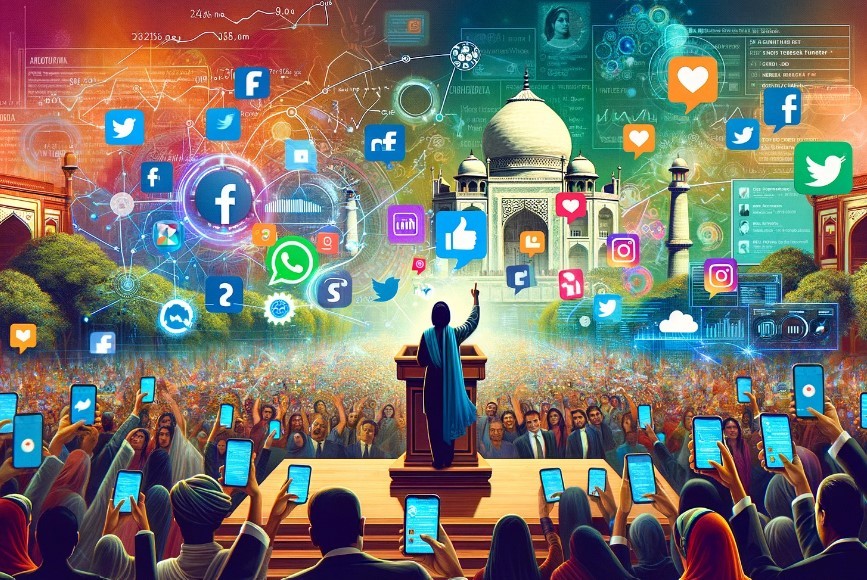Election 2024: The Social Media Juggernaut
The digital species has forayed into all aspects of our lives, and the massive impact of social media needs no intro, from the moment we wake up to the moment we close our eyes, we are mostly scrolling, scrolling, and scrolling across different social media platforms. The recent 2024 Indian Lok Sabha elections testifies to the transformative power of social media in politics. With over half a billion Indians using platforms like WhatsApp, YouTube, and Instagram, the digital battlefield has become crucial for shaping public opinion, and political campaigns.
Influencers as Political Catalysts
Home to 2.5 to 3 million content creators, India thrives on influencers who expertly engage their followers. With their substantial followings, influencers have emerged as powerful political allies. In the 2024 elections, influencers across various niches- politics, fashion, fitness, tech, and lifestyle endorsed candidates and political ideologies, leveraging their platforms to sway public opinion.
In the final stretch before the 2024 Lok Sabha elections, Prime Minister Narendra Modi was spotted engaging with top social media influencers like BeerBiceps and Curly Tales at a Delhi event.
A few years ago, leveraging influencers in political campaigns seemed unimaginable. However, in the battle for India's billion votes, these influencers became pivotal in engaging the young, disinterested, and disillusioned voters.
The creator of the Ranting Gola channel disclosed that political parties and election management firms have offered between 100,000 to 500,000 rupees for a single campaign. Traditional news can sometimes come across as dull, but influencers infuse these same stories with energy, creativity, and relatability. With personal insights and context, they make the information helpful for well-rounded and informed opinions.
The Might of Social Media
Instagram effect
While other parties struggled to match BJP’s digital prowess, the influence of digital strategies on politics, elections, and daily life continues to grow. BJP party volunteers were targeting 100,000 people a day through platforms like YouTube, Instagram WhatsApp, and Facebook.
The 2024 election was heavily influenced by Instagram, with a strong emphasis on digital-social strategies to convey their messages in a succinct and impactful manner to captivate younger voters who spend over half their day on screens, as noted by an anonymous source from an ad agency working with BJP. Instagram’s algorithm, which favours engaging content, has enabled political posts to reach a broad audience, amplifying their influence. For instance, the Bharatiya Janata Party's (BJP) use of Instagram Reels to showcase development projects and connect with young voters proved to be highly effective.
For their campaigns, Congress enlisted ad agency, DDB Mudra, while BJP collaborated with McCann Worldgroup, Scarecrow M&C Saatchi, and several smaller boutique agencies to enhance their "Abki Baar" theme through social media.
Thanks to their online presence, Rahul Gandhi's follower count on Instagram, Twitter, and YouTube experienced a dramatic spike between December 2023 and May 2024.
According to February data from the Election Commission, the 2024 elections included 18.5 million first-time voters aged 18-19. Among these young voters, Instagram's Insta Reels were particularly influential, while YouTube Shorts also saw substantial engagement.
Whatsapp: The Messaging Powerhouse
WhatsApp's role in the 2024 elections cannot be overstated. Political parties used the messaging app to run targeted campaigns, sending personalized messages, campaign updates, and multimedia content directly to voters' phones. The direct and personal nature of WhatsApp communication allowed parties to engage with voters more intimately and persuasively. The "My Vote, My Future" campaign by the Indian National Congress is a prime example, where personalized messages and multimedia content were sent to millions of voters, especially youth.
However, the use of WhatsApp also brought challenges, particularly the spread of misinformation. Political parties and fact-checking organizations worked tirelessly to counteract false information and ensure voters received accurate details. This battle against misinformation highlighted the need for digital literacy and responsible social media usage during elections. The Election Commission of India, in collaboration with tech firms, launched extensive fact-checking initiatives to curb the spread of fake news.
Short reels for the win!
Short videos and reels have become the cornerstone of digital campaigning in India's latest election. Both the BJP and Congress have strategically shifted their focus to these formats to capture the attention of voters. Between April 1 and May 30, Modi's YouTube channel saw a stark difference in engagement: 1,222 full-length videos averaged 44,000 views each, while 258 YouTube Shorts amassed around 8.5 lakh views per video. Instagram Reels were the real game-changer, with Modi’s 37 short videos racking up nearly 100 crore views. (IndianExpress)
Rahul Gandhi adopted a similar strategy but leaned more heavily on YouTube Shorts, uploading 185 Shorts that garnered 67 crore views. His Reels, however, saw fewer views at around 82.6 crore. Gandhi's approach included just 18 full-length videos, signalling a stronger reliance on the shorter format. (IndianExpress)
This election marked a pivotal moment for digital campaigns. According to an internal survey by Congress, Instagram surpassed WhatsApp as the leading source of election-related information, prompting a campaign heavily focused on Reels.
The Influence Game: How Online Content is Shaping Minds
In today's digital age, what the audience sees holds immense power. It can influence them positively, negatively, or not at all. People have their perspectives, yet they are still swayed by what they encounter online, especially from renowned figures or those they follow.
Take AI-generated deepfakes, for example; they create both positive and negative impacts. Recently, viral deepfake videos of Bollywood stars Ranveer Singh and Aamir Khan criticizing the government and endorsing the Congress Party were exposed as fake. Their followers were influenced until the truth came out, flipping their perceptions.
Contrarily, technology was used to revive deceased political icons, leveraging their popularity to sway public opinion, and simulating debates to provide voters with diverse viewpoints.
Content creators, influencers, or YouTubers, if they have a strong presence and loyal followers, they wield tremendous power to shape public opinion, be it politics, economy, or anything at all. Underestimating the transformative impact of social media would be a mistake—it's powerful, pervasive, and immensely transformative.

